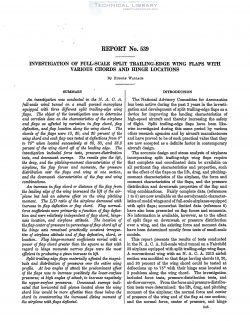naca-report-539

- Version
- 201 Downloads
- 2.19 MB File Size
- 1 File Count
- August 30, 2016 Create Date
- August 30, 2016 Last Updated
National Advisory Committee for Aeronautics, Report - Investigation of Full Scale Split Trailing Edge Flaps with Various Chords and Hinge Locations

An investigation was conducted in the N. A. 0. A.
full-scale wind tunnel on a small parasol monoplane
equipped with three difi'erent split trailing—edge wing
flaps. The object of the investigation was to determine
and correlate data on the characteristics of the airplane
and flaps as afiected by variation in flap chord, flap
deflection, and flap location along the wing chord. The
chords of the flaps were 10, £0, and 30 percent of the
wing chord and each flap was tested at deflections from 0°
to 75° when located successively at 6‘8, 80, and 88.8
percent of the wing chord aft of the leading edge. The
investigation included force tests, pressure—distribution
tests, and doumwash surveys. The results give the lift,
the drag, and the pitching-moment characteristics of the
airplane, the flap forces and moments, the pressure
distribution over the flaps and wing at one section,
and the down/wash characteristics of the flap and wing
combinations.
An increase in jlap chord or distance of the flap from
the leading edge of the wing increased the lift of the air-
.plane but had an adverse efl'ect on the wing pitching
moment. The LID ratio of the airplane decreased with
increase in flap deflection or flap chord. Flap nonnat-
force coefiicients were primarily a junction of flap deflec-
tion and were relatively independent Qfflap chord, hinge:
axis location, and airplane attitude. The location of
the flap center of pressure in percentage of flap chord aft of
the hinge axis remained practically constant irrespec-
tive of airplane attitude and of flap deflection, chord, or
location. Flap hinge-moment coeflicients varied with a
power of flap chord greater than the square so that with
regard to hinge moments narrow flaps were the most
efi‘icient in producing a given increase in lift.
| File | Action |
|---|---|
| naca-report-539 Investigation of Full Scale Split Trailing Edge Flaps with Various Chords and Hinge Locations.pdf | Download |

Comment On This Post